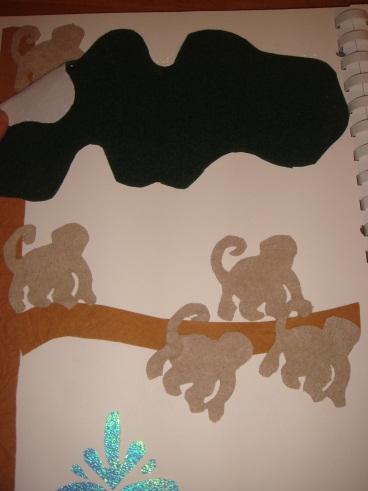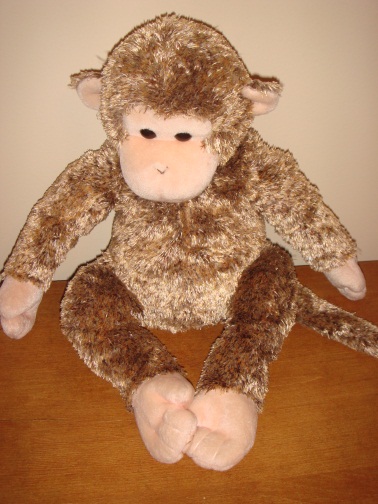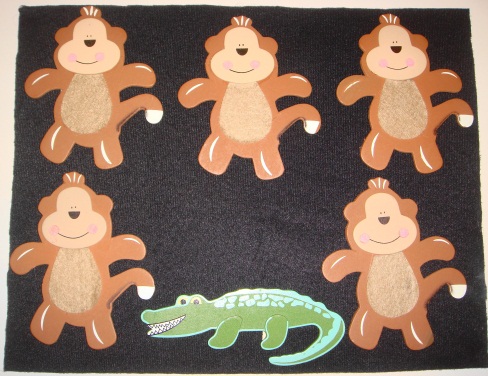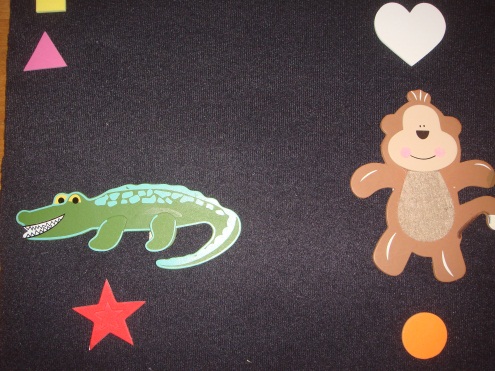Circle Time Braille Kit: Five Little Monkeys

I have created a number of emerging literacy kits for TVIs to use to help young children to develop pre-braille skills. Each kit includes print/braille books with tactile pictures, real objects, activities, interactive concept alphabet book,extensive teacher guide, etc. Each interactive book is based on one letter of the alphabet and is all concepts (not nouns) that start with that letter. Each teacher guide follows the same type of set-up and include similar types of activities - the activities all mirror what is done in the mainstream kindergarten classrooms in North Carolina. These are the kinds of activities our emerging braille kids miss as they are typically pulled out to learn the braille code.
See the interactive book for the letter "m" that goes with this post.
Five Little Monkeys Sitting in a Tree
By Eileen Christelow
Illustrated by Eileen Christelow
Theme: Five Little Monkeys is a Circle Time Pre-Braille Kit that focuses on counting to five, prepositions, monkey and crocodile fun facts, and the letter M.
Warning: There are small pieces in this kit that may not be appropriate for all students. Students should be closely supervised when using items in this kit. Please be sure to teach (and monitor) gentle handling of the objects and tactile materials to ensure safety and to increase the kit’s lifespan.
This Circle Time PRE-BRAILLE Kit Contains:
Tactile Books:
- illustrated print book with braille added
- print/braille/tactile book WITH PHOTOS
- print/ braille/tactile book (click on link to download directions)
- Interactive Alphabet Book "m" WITH PHOTOS
- Interactive Alphabet Book: “m” (click on link to download directions)
Auditory Story:
• recommend using iPad /iTouch/iPhone app “Five Little Monkeys Sitting in a Tree” by OM Book
Story Board: 5 wooden monkeys, wooden crocodile, foam shapes
Object: Stuffed animal monkey and plastic crocodile
Teacher Hints (before the student reads the story):
-
Transcribers Note: Grade I (uncontracted) braille is used in both the print and tactile books.

- The illustrations give clues to what happens to each monkey. The words in the book lead you to think that the crocodile has eaten each monkey; however, the pictures show that instead of the monkey falling into the water, the monkey is actually hiding in the leaves of a higher branch. A small portion of the monkey sticks out from under the felt leaves. The leaves can be folded back so the student can “find” more of the monkey. Depending on the student, the teacher may decide to read the story the first time through without pointing out the “hidden” monkeys.
- The student should be encouraged to “explore” (or search) the entire tactile illustration in order to find each hidden monkey. The tactile graphics are consistent on pages that are similar. (Example: The pages that have the repetitive phrase, “____ little monkeys, sitting in a tree, tease Mr. Crocodile. . .” only have monkeys sitting on the lower branch; there is no upper branch. The page that has “Oh, no! Where is he?” shows the upper branch with the monkeys hidden under the leaves.) On every page, encourage the student to search for and count all the monkeys.
-
Describe monkeys and discuss the monkey Fun Facts:
- Ask the student to explore the stuffed monkey and name the parts of the monkey.
-
Monkeys look a lot
 like people; however, monkeys are furry and have a long strong tail. They use their feet and tail like hands. They can climb and swing from branch to branch using just their tails! (Playground “monkey bars” are called “monkey bars” because kids look like monkeys as they swing from bar to bar!) Monkeys are very fury except for their face, inside their ears, and on their hands and feet. Monkeys eat fruit, nuts, leaves, flowers, insects and bird eggs. Just like people, monkeys peel their bananas before eating them. Baby monkeys are called “infants”. Monkeys like to sleep high in the trees where they are safe. Baby monkeys sleep in their mother’s arms.
like people; however, monkeys are furry and have a long strong tail. They use their feet and tail like hands. They can climb and swing from branch to branch using just their tails! (Playground “monkey bars” are called “monkey bars” because kids look like monkeys as they swing from bar to bar!) Monkeys are very fury except for their face, inside their ears, and on their hands and feet. Monkeys eat fruit, nuts, leaves, flowers, insects and bird eggs. Just like people, monkeys peel their bananas before eating them. Baby monkeys are called “infants”. Monkeys like to sleep high in the trees where they are safe. Baby monkeys sleep in their mother’s arms. -
Demonstrate how a monkey moves and how to make monkey sounds. (Use your arms to model how a monkey scratches under his arm pits and lope like a monkey while saying, “eee, eee, eee”.) Have the student act like a monkey; if possible, assist the student to swing like a monkey on the monkey bars (and/or have another student demonstrate how they can swing on the monkey bars).
• Describe crocodiles and discuss the crocodile Fun Facts:
- Ask the student to explore the realistic crocodile model and name the parts of the crocodile.
- Crocodiles have hard scaly skin, long tails, short legs and very sharp teeth. They live in swampy areas and along river banks. They swim very well with the help of their long and powerful tails. They have 48 teeth; the teeth are used to grab food but they usually swallow the food whole or in big chunks (hence the “crocodile bite”). They eat animals, fish, turtles, and birds. “Crocodile” is from the Greek word meaning lizard. Crocodiles are thought to be descendants of dinosaurs!
-
Using your arms straight out in front of your mouth with fingers spread wide and bent (to show the “teeth”), demonstrate how a crocodile opens and shuts his mouth. Have the student pretend to take “crocodile bites” out of the stuffed monkey and/or other objects.
-
Prediction Question:
There is a tactile star placed in the top right hand corner of one page in the tactile book. This star indicates the prediction question, “What do you think happened to the monkeys?” Predictions are guesses – any reasonable answer that the student gives is acceptable. If the book is being read to a group of students, ask the students for their predictions. The students can turn to their partner to discuss their predictions or the teacher can ask the student to stand up if they agree with a specific prediction answer. (The teacher may choose to ask for “thumbs up” if the student agrees or “thumbs down” if the student disagrees.) The teacher should verbalize how many students agreed or disagreed.
Activities:
-
Story Board:

Story boards are sturdy boards covered in “headliner” material that enables the wooden story characters or objects (with Velcro) to stick to the board. Students can interact with the story board as the story is being read or the student can re-enact the story using the story board. Other activities, such as counting, sequencing the story events, etc. can also be done with the story board.
-
Monkeying Around: (story board, wooden monkey, wooden crocodile and various foam shapes)
 Using preposition words (over, under, behind, beside, etc.) place the monkey, crocodile, shapes, etc. in various positions. Ask the student to name the position before removing the object from the board. Start with the monkey and place a square above the monkey and a circle below the monkey. Ask the student to find the object that is above the monkey. Tell the student to place the square above the crocodile. A variety of games can be played using these materials!
Using preposition words (over, under, behind, beside, etc.) place the monkey, crocodile, shapes, etc. in various positions. Ask the student to name the position before removing the object from the board. Start with the monkey and place a square above the monkey and a circle below the monkey. Ask the student to find the object that is above the monkey. Tell the student to place the square above the crocodile. A variety of games can be played using these materials!
-
You Can’t Catch Me Game: (stuffed monkey)
Use the stuffed monkey to demonstrate prepositions (under, over, beside, above, beneath, behind, in front, in, out, etc.) Explain that monkeys love to climb and hide. Pretend to have the monkey climb up a chair. Once the monkey is in place, have the monkey say, “You can’t catch me, I’m ABOVE the chair!” The student then pretends to be the crocodile (using his hands like a crocodile mouth opening and shutting) and say, “Snap! I can catch you, I’m above the chair too!” The crocodile snaps his mouth open and shut until he closes his mouth on the monkey. The student can switch and be the monkey (the student should name WHERE the monkey is) and the teacher (or another student) can be the crocodile. If appropriate, make the game more challenging by using harder prepositions such as “across the table”, “in the book bag”, “near the table leg”, etc. The monkey can be hidden across the room, and the student has to follow the directions to find the monkey which is now “on the teacher’s chair”. O&M routes within the classroom and around the school can also be incorporated into this game – be sure to involve the O&M instructor! (Example: The monkey is under the office counter – the student would travel to the office to find the monkey.)
-
Interactive Alphabet Book:
Circle Time Braille kits include an interactive book that focuses on one letter of the alphabet. Each page in the book will have that letter and a word starting with that letter at the top of each page. At the bottom of the page will be directions (if appropriate) and the letter brailled repeatedly in a line across the page. The Five Little Monkeys book focuses on the letter M and has a line of brailled M’s across the bottom of the page. The student should be encouraged to find the letter M at the top of the page and, with help, “read” the letter and the word. After the student has explored the things on that page, he should be encouraged to “read” the line of brailled M letters at the bottom of the page. Encourage the student to say the phonetic sound (mmmmm) as he “reads” each letter. If the student uses one hand to “read”, encourage him by saying, “Fast braille readers use two hands!” and then demonstrate by “reading” the letters and saying the phonetic sound as quickly as possible. Demonstrate slow, one handed braille reading by slowly saying the phonetic sound as you slowly “read” across the page. Each page will contain an activity or a concept development that starts with the letter M. Most pages are “interactive”, meaning that the student has to move at least one item on that page.
page. At the bottom of the page will be directions (if appropriate) and the letter brailled repeatedly in a line across the page. The Five Little Monkeys book focuses on the letter M and has a line of brailled M’s across the bottom of the page. The student should be encouraged to find the letter M at the top of the page and, with help, “read” the letter and the word. After the student has explored the things on that page, he should be encouraged to “read” the line of brailled M letters at the bottom of the page. Encourage the student to say the phonetic sound (mmmmm) as he “reads” each letter. If the student uses one hand to “read”, encourage him by saying, “Fast braille readers use two hands!” and then demonstrate by “reading” the letters and saying the phonetic sound as quickly as possible. Demonstrate slow, one handed braille reading by slowly saying the phonetic sound as you slowly “read” across the page. Each page will contain an activity or a concept development that starts with the letter M. Most pages are “interactive”, meaning that the student has to move at least one item on that page.
Concepts in the M Book: (Move the shapes to the top of the page, Match the shapes, sort and Mix the Money, find the way through the Maze, place the triangle in the Middle, put More hearts on the left, count the Monkeys, track the line to find the Man, etc.)
- Each interactive book will have a ziplock bag with items in the bag. The M book has 2 ziplock bags with money (pennies, and quarters) to sort and then “mix” together.
- The last page has index cards and envelopes. Each index card has one brailled letter. In this M book, if the brailled letter is M, the index card will go in the “yes” envelope; if the letter is not M, the index card will go in the “no” envelope.
-
Who Did What? Comprehension game:
The teacher chooses which “W” questions to ask (Who did What, Where? For this story, When and Why are harder questions and not as appropriate):
After reading the story, ask the student Who? Who was in the story? (5 monkeys, mama monkey, crocodile) Did What? What happened in the story? (Monkeys teased the crocodile but instead of falling into the water, each monkey hid in the tree. The monkeys learned it was not nice to tease the crocodile.) When? (The When question is not easily answered in this story). Where? Where were the monkeys? Where was the crocodile? Can also ask where was Mama Monkey when the monkeys were teasing the crocodile? (Monkeys were in the tree, crocodile was in the water, and Mama Monkey was asleep on the blanket.) Why? (Could be replaced by “What happened?)”
-
Fun Facts:
Fun Facts are additional information to foster concept develop about animals that were in the story (monkeys and crocodiles). If appropriate for your student, use the Fun Facts when exploring/learning about monkeys and crocodiles. (Fun Facts are under the monkey and crocodile descriptions.) Review the fun facts again, after reading the story and doing the activities.
-
Journal Prompt:
Describe a monkey’s tail and tell something that a monkey does with his tail. If you had a tail, what would you do?

